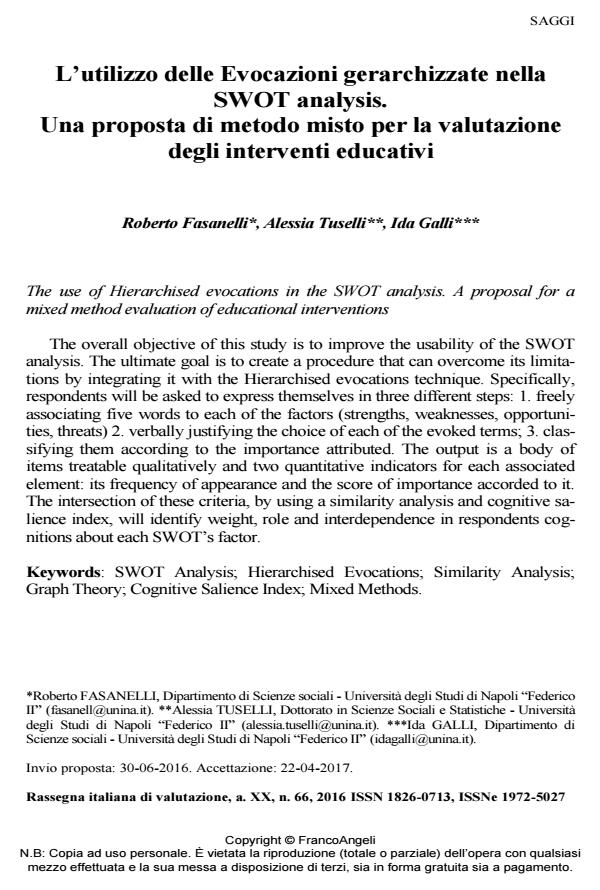L’utilizzo delle Evocazioni gerarchizzate nella SWOT analysis. Una proposta di metodo misto per la valutazione degli interventi educativi
Titolo Rivista RIV Rassegna Italiana di Valutazione
Autori/Curatori Roberto Fasanelli, Alessia Tuselli, Ida Galli
Anno di pubblicazione 2017 Fascicolo 2016/66
Lingua Italiano Numero pagine 27 P. 76-102 Dimensione file 640 KB
DOI 10.3280/RIV2016-066006
Il DOI è il codice a barre della proprietà intellettuale: per saperne di più
clicca qui
Qui sotto puoi vedere in anteprima la prima pagina di questo articolo.
Se questo articolo ti interessa, lo puoi acquistare (e scaricare in formato pdf) seguendo le facili indicazioni per acquistare il download credit. Acquista Download Credits per scaricare questo Articolo in formato PDF

FrancoAngeli è membro della Publishers International Linking Association, Inc (PILA)associazione indipendente e non profit per facilitare (attraverso i servizi tecnologici implementati da CrossRef.org) l’accesso degli studiosi ai contenuti digitali nelle pubblicazioni professionali e scientifiche
The overall objective of this study is to improve the usability of the SWOT analysis. The ultimate goal is to create a procedure that can overcome its limitations by integrating it with the Hierarchised evocations technique. Specifically, respondents will be asked to express themselves in three different steps: 1. freely associating five words to each of the factors (strengths, weaknesses, opportunities, threats) 2. verbally justifying the choice of each of the evoked terms; 3. classifying them according to the importance attributed. The output is a body of items treatable qualitatively and two quantitative indicators for each associated element: its frequency of appearance and the score of importance accorded to it. The intersection of these criteria, by using a similarity analysis and cognitive salience index, will identify weight, role and interdependence in respondents cognitions about each SWOT’s factor.
Parole chiave:SWOT Analysis; Hierarchised Evocations; Similarity Analysis; Graph Theory; Cognitive Salience Index; Mixed Methods.
- La rappresentazione sociale di (dis)obbedienza nei giovani militari italiani Maura Pozzi, Carlo Pistoni, Daniela Marzana, Lorenza Arpini, Sabina Moro, Elena Marta, in RICERCHE DI PSICOLOGIA 3/2021 pp.1
DOI: 10.3280/rip2021oa12861 - Representaciones sociales de la donación de leche humana: un estudio en cuatro ciudades de Colombia Gloria Yaneth Pinzón-Villate, Luz Arboleda-Montoya, Felipe Ramírez-Cortazar, in Revista Colombiana de Sociología /2021 pp.17
DOI: 10.15446/rcs.v44n2.87614 - What drives the value of football clubs: An approach based on private and socio-emotional benefits Riccardo Tiscini, Alberto Dello Strologo, in Corporate Ownership and Control /2016 pp.673
DOI: 10.22495/cocv14i1c4art14
Roberto Fasanelli, Alessia Tuselli, Ida Galli, L’utilizzo delle Evocazioni gerarchizzate nella SWOT analysis. Una proposta di metodo misto per la valutazione degli interventi educativi in "RIV Rassegna Italiana di Valutazione" 66/2016, pp 76-102, DOI: 10.3280/RIV2016-066006